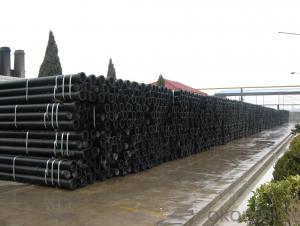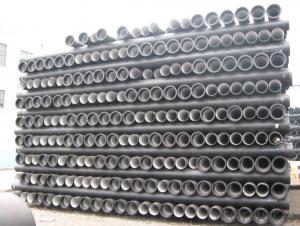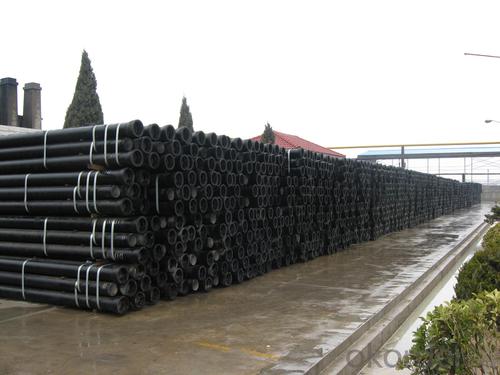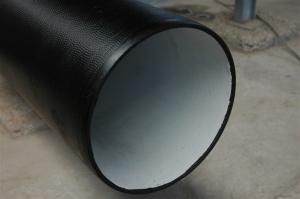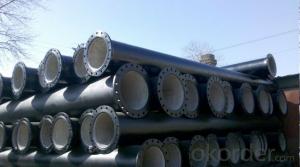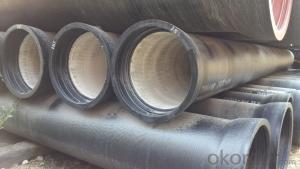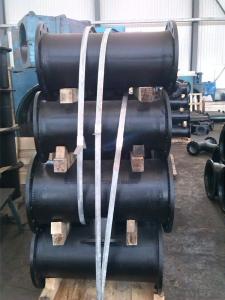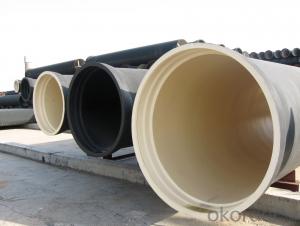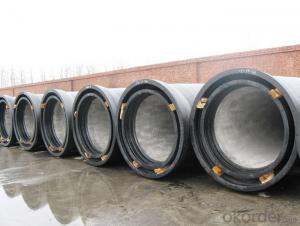Ductile Iron Pipe DN80
- Loading Port:
- Tianjin
- Payment Terms:
- TT or LC
- Min Order Qty:
- 23 m.t.
- Supply Capability:
- -
OKorder Service Pledge
OKorder Financial Service
You Might Also Like
Specifications
Quick Details
| Place of Origin: | China (Mainland) | Brand Name: | CMAX | Model Number: | T type / K type / Flange type |
| Length: | 6m / 5.7m / Negotiable | Standard: | ISO2531 / EN545 / EN598 | Application: | Potable / Sewage water |
| Diameter: | DN80~DN2200 | Shape: | Round | Hardness: | 230 |
| Pipe Wall Thickness: | standard | Pull Strength: | 420 | Yield (≥ MPa): | 300 |
| Material: | Ductile Iron | Type: | Centrifugal ductile cast iron pipe | Certification: | ISO2531 / EN545 / EN598 |
| Outer Diameter: | 80-2200 | Thickness: | standard | Specification: | DN80~DN2200 |
The advantages to the customer:
Trustworthy financial strength.
One-stop shopping.
Fast and efficient service.
Coordination of shipments from multiple plants.
Specialists of the overseas shipping process.
A more competitive price.
Ductile iron pipe is sized according to a dimensionless term known as the Pipe Size or Nominal Diameter (known by its French abbreviation, DN). This is roughly equivalent to the pipe's internal diameter in inches or millimeters. However, it is the external diameter of the pipe that is kept constant between changes in wall thickness, in order to maintain compatibility in joints and fittings. Consequently the internal diameter varies, sometimes significantly, from its nominal size. Nominal pipe sizes vary from 3 inches up to 64 inches, in increments of at least 1 inch, in the USA.
Pipe dimensions are standardised to the mutually incompatible AWWA C151 (U.S. Customary Units) in the USA, ISO 2531 / EN 545/598 (metric) in Europe, and AS/NZS 2280 (metric) in Australia and New Zealand. Although both metric, European and Australian are not compatible and pipes of identical nominal diameters have quite different dimensions.
Flanges are flat rings around the end of pipes which mate with an equivalent flange from another pipe, the two being held together by bolts usually passed through holes drilled through the flanges. A deformable gasket, usually elastomeric, placed between raised faces on the mating flanges provides the seal. Flanges are designed to a large number of specifications that differ because of dimensional variations in pipes sizes and pressure requirements, and because of independent standards development. In the U.S. flanges are either threaded or welded onto the pipe. In the European market flanges are usually welded on to the pipe. In the U.S. flanges are available in a standard 125 lb. bolt pattern as well as a 250 lb (and heavier) bolt pattern (steel bolt pattern). Both are usually rated at 250 psi (1,700 kPa). A flanged joint is rigid and can bear both tension and compression as well as a limited degree of shear and bending. It also can be dismantled after assembly. Due to the rigid nature of the joint and the risk of excessive bending moment being imposed, it is advised that flanged pipework is not buried.
Current flange standards used in the water industry are ANSI B16.1 in the USA, EN 1092 in Europe, and AS/NZS 4087 in Australia and New Zealand.
Ductile iron pipe is somewhat resistant to internal corrosion in potable water and less aggressive forms of sewage. However, even where pipe material loss and consequently pipe wall reduction is slow, the deposition of corrosion products on the internal pipe wall can reduce the effective internal diameter. A variety of linings are available to reduce or eliminate corrosion, including cement mortar, polyurethane and polyethylene. Of these, cement mortar lining is by far the most common.
Polyurethane (Plastic wrap) marginally protects piping made of ductile cast iron against corrosion and ensures meeting hygienic standards for drinking water at the same time in the early years. Polyurethane is used for both the inside lining and the outside coating. Because of polyurethane's elasticity, the coating remains intact even if the pipe is deformed. A major problem is that the poly wrap is not able to be uniformly installed or even installed without rips and creates isolated corrosion attacks. Corrosion Experts
Polyurethane coatings were first used in 1972.[citation needed] In comparison with other coatings, the internal polyurethane lining exhibits a high resistance to various different media such as drinking water, wastewater, de-mineralised water, industrial water and gas, as well as to aggressive solutions such as sulphuric acid. The polyurethane outside coating is suitable for all kinds of soil.
Polyurethane is a thermosetting plastic with no solvents, with a three-dimensionally linked molecular structure giving it mechanical stability. The polyurethane used for conating has the following standard properties, according to EN 545 and ISO 2531 standards.
- Q: Are ductile iron pipes suitable for horizontal auger boring installations?
- Yes, ductile iron pipes are suitable for horizontal auger boring installations. Ductile iron pipes have excellent strength and durability, making them ideal for underground installations. They can withstand the lateral forces and vibrations involved in auger boring, ensuring a reliable and long-lasting pipeline system.
- Q: Are ductile iron pipes suitable for use in irrigation canals?
- Yes, ductile iron pipes are suitable for use in irrigation canals. Ductile iron pipes are known for their strength and durability, making them an excellent choice for carrying water in irrigation systems. They have high tensile strength and can withstand the heavy loads and pressures typically encountered in irrigation canals. Additionally, ductile iron pipes have excellent corrosion resistance, making them ideal for use in environments where water quality may vary. They are also resistant to UV rays and can withstand extreme weather conditions, which is crucial for their longevity in an irrigation canal system. Furthermore, ductile iron pipes have the ability to handle high flow rates and can efficiently transport water over long distances, ensuring effective irrigation. Overall, ductile iron pipes offer numerous benefits and are a reliable and suitable choice for use in irrigation canals.
- Q: Can ductile iron pipes be used for irrigation systems in saline soil conditions?
- Ductile iron pipes, due to their durability and corrosion resistance, can be utilized for irrigation systems in saline soil conditions. These pipes are renowned for their ability to withstand various soil conditions, including saline soil, which is characterized by elevated salt levels that can lead to corrosion and material deterioration. However, ductile iron pipes possess a protective coating, such as cement mortar lining or polyethylene encasement, that provides an added layer of defense against corrosion. Consequently, they can endure the corrosive impacts of saline soil and maintain their structural integrity for an extended duration. Moreover, ductile iron pipes exhibit a high tensile strength, enabling them to resist cracks and breaks, which is crucial for irrigation systems necessitating a consistent and dependable water supply. Consequently, ductile iron pipes represent a viable option for irrigation systems operating in saline soil conditions.
- Q: How does ductile iron pipe resist internal corrosion?
- Ductile iron pipe resists internal corrosion due to the protective barrier formed by its cement lining. This lining acts as a barrier between the iron pipe and the transported fluid, preventing direct contact and minimizing the chances of corrosion. Additionally, the high carbon content in ductile iron enhances its corrosion resistance compared to other types of iron pipes.
- Q: How do ductile iron pipes handle cyclic loading in offshore applications?
- Ductile iron pipes are known for their exceptional strength and durability, making them a suitable choice for various applications, including offshore use. When it comes to handling cyclic loading in offshore environments, ductile iron pipes have several characteristics that contribute to their performance. Firstly, ductile iron pipes have a high resistance to fatigue failure. Fatigue failure occurs when a material experiences repeated cycles of stress, which can cause cracks to initiate and propagate over time. Ductile iron pipes are designed to withstand cyclic loading without compromising their structural integrity, thanks to their inherent ductility and ability to absorb and distribute stress effectively. Additionally, ductile iron pipes possess excellent impact resistance. Offshore environments are prone to dynamic and unpredictable forces, such as waves and currents, which can exert sudden and high impact loads on the pipes. The high impact resistance of ductile iron allows it to withstand these forces without deformation or fracture, ensuring the pipes remain intact and functional. Moreover, ductile iron pipes have a unique microstructure that enables them to resist corrosion. Offshore applications expose pipes to harsh environmental conditions, including saltwater, which can accelerate the corrosion process. However, the protective graphite matrix in ductile iron pipes acts as a barrier, preventing corrosive agents from reaching the underlying metal and significantly extending the pipes' service life. Furthermore, ductile iron pipes have a high load-carrying capacity. In offshore applications, pipes often need to support heavy loads, such as those from equipment, structures, or seabed settlements. Ductile iron's superior strength allows it to bear these loads effectively, maintaining the structural integrity and stability of the system. Lastly, ductile iron pipes offer ease of installation and maintenance. Their lightweight nature makes them easier to handle and transport during offshore operations. Additionally, their corrosion resistance minimizes the need for frequent maintenance, reducing downtime and costs associated with repairs and replacements. In conclusion, ductile iron pipes exhibit excellent performance in handling cyclic loading in offshore applications. Their resistance to fatigue failure, impact resistance, corrosion resistance, high load-carrying capacity, and ease of installation and maintenance make them a reliable and efficient choice for offshore environments.
- Q: Are ductile iron pipes suitable for underground applications?
- Yes, ductile iron pipes are suitable for underground applications. They are known for their durability, strength, and resistance to corrosion, making them ideal for use in underground environments where they may be exposed to moisture and soil conditions. Additionally, ductile iron pipes have a long lifespan and can withstand heavy loads, making them a reliable choice for underground applications such as water and sewage systems.
- Q: Can ductile iron pipes be used for underground chemical processing systems?
- No, ductile iron pipes are not suitable for underground chemical processing systems as they can corrode and react with certain chemicals, compromising the integrity of the system.
- Q: Ductile iron pipe connection mode
- Jack painted on the outer surface and rubber lubricant: lubricant evenly installed ring inner surface, outer surface coating in the socket to socket socket parts lubricant line all the brush in the socket.
- Q: What is the maximum allowable deflection for ductile iron pipes?
- The maximum allowable deflection for ductile iron pipes is typically limited to 2% of the pipe's diameter.
- Q: Can ductile iron pipe be recycled?
- Yes, ductile iron pipe can be recycled. It is a highly recyclable material that can be melted down and reused in the production of new ductile iron products. Recycling ductile iron pipe helps reduce waste and conserves natural resources.
Send your message to us
Ductile Iron Pipe DN80
- Loading Port:
- Tianjin
- Payment Terms:
- TT or LC
- Min Order Qty:
- 23 m.t.
- Supply Capability:
- -
OKorder Service Pledge
OKorder Financial Service
Similar products
Hot products
Hot Searches
Related keywords
